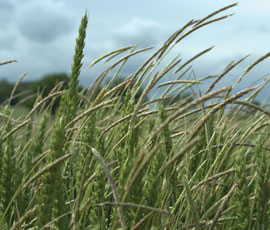Best chance for blackgrass control in seven years

Growers should take advantage of the lowest blackgrass dormancy for seven years and delay drilling as long as possible for the best control of the grassweed, say experts.
It has now been confirmed that the dormancy of the weed seed is the lowest since 2006 – the last time the summer was hot and dry.
Testing carried out from 21 locations by consultant ADAS and Rothamsted Research shows that 54% of the collected seed germinated under controlled conditions.
Hot and dry summer conditions that coincide with blackgrass flowering stress the plant, leading to a defence mechanism being triggered which results in the weed producing low dormancy seed that germinate readily.
Since the 56% germination experienced in 2006, the figure has not been above 37%, and with winter cereal drilling starting in earnest this week, ADAS researcher Sarah Cook says growers should delay as long as possible.
“The advice is always hold off drilling as long as possible where blackgrass is a problem, but this year you are likely to get good value from doing so,” she says.
“Wait for a flush or two and spray it off with glyphosate and follow up drilling with a robust pre-emergence herbicide programme,” Dr Cook adds.
Rothamsted blackgrass expert Stephen Moss says that dormancy is only “one part of the jigsaw” and much will depend on the soil moisture present ahead of drilling.
But with most of the UK experiencing wet weather in recent days, he says conditions are ideal to produce a good flush of weeds that can be controlled before drilling.
“Conditions are ideal for delaying drilling, but the lessons of last year will be difficult to banish from memory,” says Dr Moss.
Many growers that failed to get crops established in September 2012 couldn’t do so until the following spring – or in the worst cases not at all – due to persistent rainfall.
But Dr Moss says it’s a delicate balancing act to minimise the risk of high blackgrass populations in the crop and maximising yield potential with the optimum drilling date.
“Delaying drilling is one of the most effective ways of controlling blackgrass, but some may choose not to risk it because of last year,” he says.
“The current moist soils should result in good efficacy of residual pre-emergence herbicides this autumn and will also push people towards drilling earlier,” he explains.
Dr Moss says the level of risk for high blackgrass infestations will depend upon the amount of seed shed in the first place and also whether herbicide resistance is present in the blackgrass populations.
“In the worst fields or where resistance is a factor, people should still try to delay drilling to keep blackgrass in the crop to a minimum,” he adds.
Cultivation method should also be considered and Dr Cook says that growers should think about where the blackgrass seed is before deciding on whether a rotational plough should be considered in a non-inversion tillage system.
“Depending on the cultivation system you use, the previous years’ blackgrass seed will be distributed through the soil profile differently,” she says.
Where seed return has been high this year, she adds that rotational ploughing might be the correct option.
“Ploughing generally brings up less seed than is buried and the moist conditions should mean it will germinate rapidly for spraying off before drilling,” says Dr Cook.
Blackgrass management – dormancy
High dormancy | Low dormancy | |
Pre-harvest glyphosate application | No effect | Check and treat if blackgrass is emerging in wet conditions |
Black-grass emergence | More protracted, 90% emergence 60 days after drilling | 90% emergence 30 days after drilling |
Cultivations | Plough – unless low weed populations | Non-inversion |
Drilling | Early encourages crop competition | Delay for maximum weed emergence |
Pre-emergence herbicide | Use robust mixture with a residual component – for example, Crystal | Apply immediately after drilling |
Post-emergence herbicide | Could be delayed but add a residual if applied early | Apply early, once most germination is complete |

